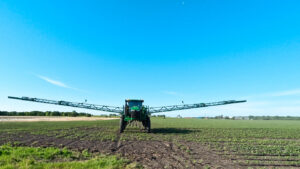Editor’s Note: Rob Trice is a veteran venture capital investor currently leveraging his background in telecom, mobile and internet investing to fund food and agriculture IT startups. He does so through his venture firm Better Food Ventures, and he’s also founder of The Mixing Bowl, a forum to help scale startups in the space.
Here Trice shares his thoughts on how agtech entrepreneurs are building their businesses and how it compares to other sectors ahead of his next event in Silicon Valley next month.
The ‘design thinking’ and ‘lean startup’ methodologies are en vogue. But do these approaches work for agtech?

In 2014, Steve Blank spoke at the first ever Mixing Bowl FOOD IT event at Stanford. Steve is a former entrepreneur who now teaches at Stanford and Berkeley and is best know as the father of the Lean Startup Approach and co-author of “The Startup Owner’s Manual”.
He defines startups as business organizations set up to search for a new idea, product or business model. The value of a design process and lean startup methodology to startups is to help them identify problems worth solving in terms of market demand and even potential social and environmental impacts.
As Steve describes in his fireside chat with me at FOOD IT (starts at minute 45), there are three pieces of the lean startup process that startups should utilize as an integral part of their maturation.
The first piece is a design phase, where a startup engages with potential customers, clients, or users, as a way to gain insight into potential market opportunities. Building on these insights, a startup develops a hypothesis about who to target and what to build in order to satisfy their needs.
The second aspect of the lean startup methodology involves validating one’s hypothesis by building simple prototypes to test with potential users. Startups do this as a way to better understand whether their user’s needs are real and/or whether their solution idea meets their user’s need or not. In this way, a startup is able to fail early and affordably, which in turn allows them to iterate quickly and in a way that ensures their idea has real demand in the market place.
The third aspect of the lean startup methodology involves building a “minimally viable product” to which a startup adds and tweaks features based on observing the user’s experience with the product. Once a startup finds a product/market fit, it then evolves from an iterative to an execution-oriented mindset.
As Steve points out, the real value of this design thinking and lean methodology is that it helps startups focus first on identifying unmet demand in the market and then on identifying and testing different ways to meet that demand, as opposed to investing heavily in a solution first, and then seeking market potential for the solution subsequently. This user-centric and iterative approach has proven to be a more affordable and faster way for startups to realize success.
EXAMPLES OF LEAN STARTUP METHODOLOGY IN AGTECH
There are examples of the lean methodology being used in agtech already. One company, weeding robot manufacturer Blue River Technology, emerged from Steve’s course at Stanford. In his conversation with me, Steve tells the story of how Blue River first started off as a robotic lawn mower, but through the lean startup process eventually pivoted to the agricultural sector. Now, with over $30m raised from venture capital firms like Khosla Ventures and Monsanto Growth Ventures, their LettuceBot computer vision and robotics technology is in use in fields that supply 10% of the lettuce consumed in the US annually.
Pasture Map, another agtech startup to launch from Steve’s class at Stanford, has developed a solution to help ranchers optimize the productive capacity of their rangelands. Christine Su, the company’s founder, and her team, started by engaging with hundreds of ranchers with the goal of unearthing important unmet needs in the industry. Their process eventually led to their current solution, and now they are working with ranchers operating across the US, as well as overseas in places like New Zealand.
EXPLORING OPPORTUNITIES FOR INNOVATION IN AGTECH
The pace of innovation in agtech is accelerating through the use of the lean startup methodology and other similar processes like “design thinking” but their application in the sector is still relatively nascent. In my view, these approaches have value for both upstarts and incumbents.
New entrants like BlueRiver and PastureMap have used these processes to hone grounded solutions to real problems faced by agricultural producers. This user-centric approach could be employed more frequently to avoid what one friend of mine from the Midwest calls, “Silicon Valley agtech” which is rooted in an arrogant assumption that farmers and ranchers are desperate for and/or can easily pay for any and all kinds of shiny new technologies.
For more established companies, the methodologies and mindsets of lean startup and design thinking could be quite valuable in helping organizations shift from a reactive posture, to a more proactive posture with respect to changing demands in the market, changes in climate, and new regulation.
There is nothing fundamentally different about the food and agriculture industry that prevents these new innovation processes from being applied to these sectors. It may only be that today other vertical markets can take greater advantage of the agility of these methods more. As an example, let’s compare the use of these tools in a social media app against a food/agtech product to point out three key differences:
SEEDS & SEASONS
Unlike the totally digital world of a social media app, food and agriculture is comprised of living organisms that are often bounded by incontrovertible laws of nature. As Vonnie Estes covers in a recent AgFunderNews piece, there are amazing new technologies enabling us to model and iterate on seed genotyping and measure crop performance in nearer real time. But, as an example, there are limitations to how large we can humanely breed a chicken’s breast before the animal simply cannot stand up on its own. And even with climate change, the seasons of the year are still mostly intact, so the element of seasonality can be a barrier to rapidity and creates a context one doesn’t encounter writing code for an app.
SAFETY
Unlike a social media app, if one makes a mistake with a food or agriculture product, the consequences can be deadly. Thousands of people in the US die every year from food borne pathogens. There are great technologies coming that will strengthen our testing capabilities and reduce our food testing times, but the fact remains today that food testing is less than perfect and not real-time. Testing and approval regimes may hinder the pace of innovation in food and agriculture, but are an essential requirement for animal and human safety.
SCALING
As agile as a startup company may be, the reality is that they need to operate in a broader ecosystem. As opposed to a social media app that can simply upgrade its product or pricing via software, and has a direct relationship with an end consumer to grow virally through clicks and “likes”, food and agriculture deals in physical products processed and moved in an ecosystem that has parts that are still quite antiquated. This challenges the speed of the iteration cycle and can very well limit the velocity of scaling a food and agriculture innovation.
TAKING THE FIRST STEP TOGETHER
Many in the food and agriculture space have yet to be exposed to these impactful ways of innovating. To that end, The Mixing Bowl, along with our organizing partners, Stanford’s FEED Collaborative and Forbes Media, will be utilizing basic principles and practices of design thinking as part of this year’s FOOD IT event agenda. Attendees will participate in identifying interesting opportunities for innovation and in exploring how emerging technologies might be applied in new and novel ways across the food system.
We hope you will join us July 12th at the Computer History Museum in Mountain View, CA for the FOOD IT: Solution Harvest, the day before the Forbes Agtech Summit begins in Salinas, to participate in an exciting event format intended to facilitate uncommon collaborations and conversations.




